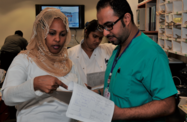The Kingdom is launching a massive health care sector spending programme, a priority in a country where population growth, increasing numbers of religious tourists and a rise in lifestyle-associated illnesses are putting pressure on existing medical infrastructure.
In late December 2011, the Saudi government pledged to increase budgetary spending on health care by 26% in 2012, a significant jump in year-on-year expenditure. In 2009, the Kingdom invested $13.86bn in health services, approximately 11% of the total budget. This rose to $16.58bn in 2010 and to $18.32bn in 2011, or 11.3% and 11.8% of the national budget, respectively.
Much of the spending will go towards modernising and expanding the country’s network of government hospitals. The Ministry of Health’s (MoH) strategic five-year plan, launched in 2011, is largely focused on building 121 new hospitals and renovating a further 66.
In February, Abdullah Al Rabeeah, the minister of health, authorised payment of $373.26m for construction of the first phase of the King Faisal Medical City (KFMC), a 1350-bed facility in Saudi Arabia’s Southern Province.
In the same month the minister also gave approval for the construction of a 300-bed child and maternity hospital in Al Jouf, a city in the north of the Kingdom. The project, awarded to Musad Al Otaibi Contracting Company, will cost $67.19m.
This fillip to the medical sector comes as part of a broader $34.66bn public spending package instigated by King Abdullah Bin Abdulaziz Al Saud in 2011. This investment in public housing, health care and infrastructure has contributed towards the Kingdom’s buoyant economic growth. Indeed, the economy is expected to grow by 4.7% in 2012, according to Standard Chartered Bank.
But this recently ramped-up focus on health care provision is by no means a new issue. According to Fayad Dandashi, the CEO of Futuremed, this is a long running challenge for the Kingdom. “In terms of the number of beds, doctors and nurses per–capita, we fall behind most of the GCC and developed countries,” he told OBG.
Dandashi said that public health care provision has lagged private sector dynamism. “Over the past decade, private sector spending has been the driving force in new health care projects. However, the government has massively increased funding for health care infrastructure projects, building capacity and subsidising mega private-sector initiatives.”
Of the 415 hospitals in Saudi Arabia, 127 are operated privately. According to MoH statistics, there are now 58,126 hospital beds in the Kingdom, 12,817 of which are in private institutions.
The country has the biggest and fastest-growing population of all the GCC countries. The population is an estimated 27m, according to the Central Department of Statistics and Information (CSDI), and this figure is expected to reach 31.6m by 2016. Additionally, the Kingdom receives more than 20m visitors each year for the Hajj and Umra pilgrimages, a number that grows steadily each year, putting further strain on the system.
This pressure is further compounded by a sharp rise in lifestyle-associated, non-communicable illnesses, such as obesity, diabetes and hypertension. McKinsey & Company, a US-based consultancy firm, estimates that instances of cardiovascular disease and diabetes will increase by 240% by 2025. This represents an considerable financial burden: according to the King Abdulaziz City for Science and Technology, expenses caused by cardiovascular disease will reach $21.33bn by 2032, while diabetes will cost the Kingdom $31.99bn by 2035.
Ayman Tamer, the president of Tamer Group, a local health care company, told OBG that non-communicable diseases are “one of the biggest threats we face; they seriously affect the economy and productivity of any community”. The key, according to Tamer, will be a strategic swing towards preventative health care through public health awareness and rapid diagnostics.
Nevertheless, despite this increase in public spending, private sector investment will continue to play a vital role. According to Loay Nazer, the chairman of BUPA Arabia, much could be done to further facilitate investment. “Currently, insurance companies, foreign firms and Saudi joint-stock companies with foreign ownership are unable to own hospitals or clinics,” Nazer told OBG. “There is a real need for increased investment, so opportunities should be opened up to new players.”

